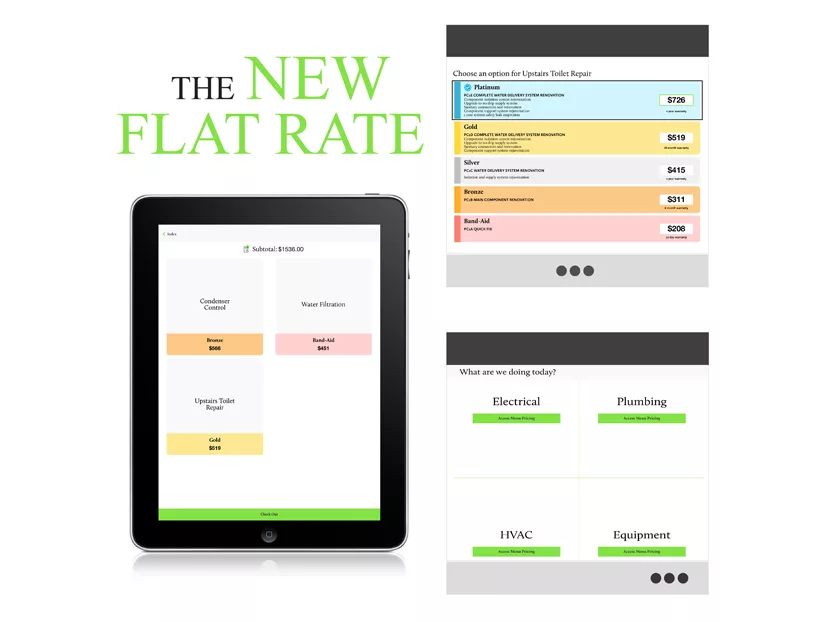The New Flat Rate claims to be the first selling tool that actually sells. In an industry that is notoriously known for its struggles to keep and find solid talent, a comment this bold may raise a few eyebrows.
The Dalton, Georgia-based company was founded by Rodney Koop and his daughter Danielle Putnam in 2011. Koop is a motivational speaker, author, entrepreneur and solutions-based enthusiast. He is a master electrician holding over 12 unrestricted electrical licenses. Over the last three decades, Koop has founded and sold HVAC, electrical and plumbing service companies. Having experience in everything from business development and management to operations and technology, Putnam, president of The New Flat Rate, handles the day-to-day operations, marketing, advertising and quality control for The New Flat Rate.
The New Flat Rate was born out of Koop’s experience as a struggling contractor.
“We wanted to find a way to make contracting pleasant, profitable and worthy of all the time and effort that families put into it,” Koop says.
Plumbers and techs who sell
Let’s start with what we know. When a plumber comes into a home, they are expected to build a rapport with the customer and gain a level of trust. Later on, they’re expected to provide the customer with the price of the service. This means that the first contact should be as pleasant as possible. Koop reminds us, that plumbers are also trained to look for “other opportunities,” in other words, ways to upsell the customer to make the call more profitable and more valuable for the customer.
“The number one rule of selling is everybody hates it when you try to sell them something,” Koop says. “The plumber is fighting an uphill battle. Because as soon as the customer realizes they are trying to sell them something, the customer’s sales resistance is going to turn on. There needs to be sales talent to overcome that resistance and possibly overcome rejections.”
For more than 15 years, over one hundred million dollars has been spent on just training plumbers and technicians how to sell and upsell in the home.
“All statistics show that that one hundred million has been wasted,” Koop says. “Service technicians don’t want to sell. Period. Because they are born from their mother’s womb with an insatiable desire to help you, serve you and be your friend. The last thing they want is for you to think they’re trying to take advantage of you. It goes against the nature of the service person.”
Our industry still leans toward hiring people based off their sales skills and then teaching them to be plumbers and technicians. The thing is, Koop says, that if you can find someone who can upsell and sell in the home and also fix things, then you’ve found a very intelligent individual. And there’s a particular name for that individual.
“The name isn’t service technician or plumber; it’s entrepreneur,” Koop says. “Anyone that uses sales skills and technical skills won’t be working for you very long because they are on a career path. Someone is going to hire them away from you, and then they’re going to start their own company.”
So, what happens to all the plumbers and technicians who start their own show? Koop says that the number one problem for contractors today is that the phone is ringing everywhere else.
“It’s not that the phone isn’t ringing; it’s just that it’s now ringing in 100 places when it used to ring in 1,” Koop explains. “We ran them all off, and now they work for themselves. There’s no shortage of labor. It’s just spread out.”
This fragmentation is something that Koop has seen firsthand. “When I first got into this business, I kept trying to figure out why it wasn’t easier,” he says.
Koop was involved in Nexstar, AirTime 500 and other best practice groups for years. He and his son, Matt Koop, had done extensive training with various consultants and trainers. Matt had been running the service truck, pulling in $600,000, while Rodney was pulling in close to $400,000. In 2010, their company went from 18 employees down to three — Rodney, Matt and Danielle.
Part of the reason he ran into the same predicaments as everyone else, Rodney explains, is because the industry as a whole accepted the same line of thinking when it came to selling.
“Everyone was doing the same thing. Everyone believed that you can make a plumber and technician sell and upsell in the home. And all the costs for trying to make that happen drove the overhead up in a normal service company, and our industry said, ‘raise your prices,’” Koop says. “We now have some HVAC and plumbing companies that charge over $500 an hour. Not one of those contractors would hire a painter in their house and pay him $500 an hour.”
The idea behind Menu Pricing
So, how did Koop decide to do something different? Well, in 2010, when he and his family hit rock bottom like so many other contractors, he decided to do some analysis. Koop pulled six months’ worth of his son’s service tickets and found that he had stapled a yellow sheet of paper to every single one of them. Matt had written four to six options on every service call. This is when realization set in.
“I thought, ‘What if I turn this into a book?’” Then I can hire someone who simply shows the customer a page. That was the beginning of Menu Pricing,” Koop says. “I didn’t know the power of a menu at the time.”
After seven years of trial and error, New Flat Rate has over 400 clients across all 50 states and in Canada and Australia. The New Flat Rate system is being used over 20,000 times a week, and over a billion dollars has been transacted. Clients are averaging $2,000-$4,000 per truck every week.
“It turns out we’ve been leaving a lot of profit on the table in these businesses,” Koop explains. “We always knew we were, but not how much.”
Because of this breakthrough in profit, clients have been able to pay off personal debt, open new shops, replace their fleet, build a retirement legacy to three years and provide better insurance and pay to employees.
“We flooded the industry with money, and it’s very much needed,” Koop says.
If this sounds like ground-breaking stuff to the service industry, it’s because it is. And the New Flat Rate is being flooded with success stories because of it. Currently, they are in the process of integrating an interactive map on their website, where potential customers can click on a state and see various testimonies of happy clients.
Plumbing and HVAC contractors have had game-changing experiences with the New Flat Rate system.
“From the time we beta-tested in 2011 until now, we’ve noticed that the national average service invoice in HVAC runs around $230 to $250,” Koop explains. “With our system it typically runs from $400 to $550. In plumbing, the national flat rate is 370 to 390, and with our system it typically runs 550 to 650.”
Okay, so how does it work?
The New Flat Rate works by providing a menu for every task or repair. With this system, Koop explains, techs can be techs.
“Now, their primary purpose is to diagnose and repair,” Koop says.
It still starts at the door. The tech greets the customer as they normally would, informs them that they will check out the issue and lets them know that they have options. This process at the door should take up to three minutes and requires less schmoozing on the tech’s end.
“They no longer have to spend 15 to 20 minutes trying to build a relationship,” Koop explains, “which takes all that pressure off the tech.”
Then the tech completes the diagnosis. With the diagnosis, the tech pulls up the New Flat Rate app on their iPad, navigates the index and pulls up the page that relates to the diagnosis. Each page is like the menu of a restaurant. After the tech selects the correct page, they will present it to the customer. If they notice anything else in the home, they will select the page that relates to that issue and include it in their summary.
The tech will show the first page to the customer. It will have roughly five options. “Most customers choose an option within 10 seconds or less,” Koop says.
It’s important for the tech to clarify with the customer that they are free to choose any option they want. “We don’t want them to feel like we’re trying to manipulate or upsell in any way,” Koop explains.
The customer, who is now fully aware of their options, will not succumb to sales resistance or even object to the prices. Here lies the true power the menu.
“It’s virtually impossible for there to be a price objection if a menu is built properly,” Koop says.
Show me the options
Remember that the customer has five basic options when selecting a service on a menu. Options include Basic (Band Aid), Bronze, Silver, Gold and Platinum.
The Basic option is the always the bottom solution for making a repair, or the first go-to in a flat rate system. It’s exactly what the customer asked for. “We call it the ‘Band Aid’ because it’s a high-quality solution for a small problem,” Koop says.
The Bronze level features good service and a warranty. “The Bronze level is designed to eliminate call-backs,” Koop explains. “The technician might tighten all the terminations, check the grounding and bonding, check the mechanical systems … things that don’t cost a lot to do, but add a lot of value.”
The Silver option is the most popular choice. At this level, again, the customer gets more time and attention, and a better warranty. “At Silver, we’re doing the same things we’ve already done, but then we will typically add a performance feature to make sure the customer is getting the payback they should be getting,” Koop says.
The higher levels — Gold and Platinum — focus on restoration and have much better warranties. Platinum also includes a return visit.
One thing to note about all the options is that they don’t include any parts. That’s because skill takes precedence. “We’re not trying to get customers to buy more stuff as they move up,” Koop explains. “We’d like for them to buy more skill, knowledge, wisdom and attention. And the customer will pay more money for that than for the extra flapper on their toilet or thermostat on their water heater.”
With the New Flat Rate system, everyone seems to win. What this can do for a trade is give it back its true worth.
“Now we can appreciate skilled plumbers and technicians for their core talent and their ability to do great work and solve problems,” Koop says. “This is a game-changer because it has such an effect on morale.”
Visit thenewflatrate.com.





